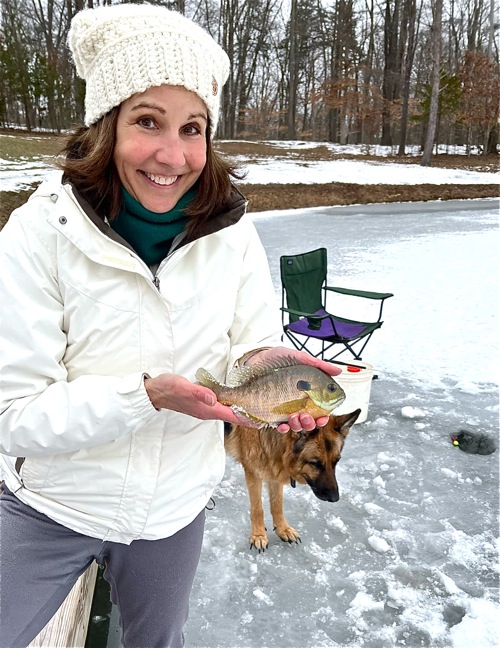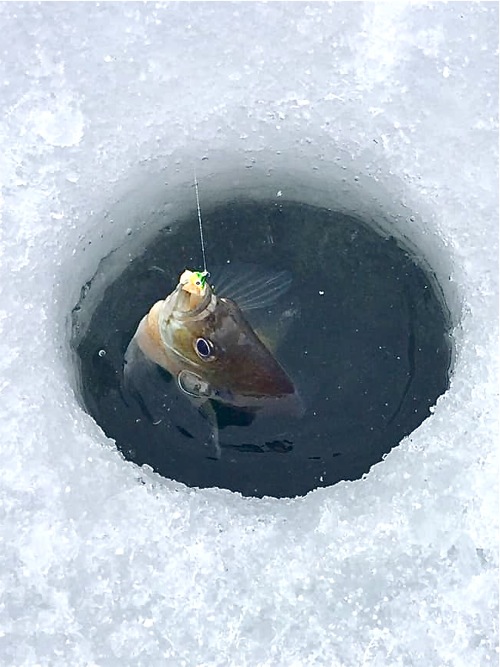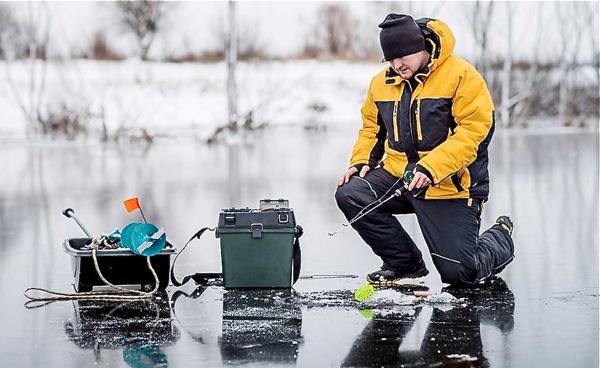It’s a novelty to some. A form of cult for others. But however you view ice-fishing, there’s a list of do’s and don’ts that you’d better learn if and when you try it. I once learned the hard way.
By Jim Abrams for Press Pros
(Ed. Note: Jim Abrams is a retired officer for the Ohio Department of Natural Resources. His views are his own, and he advocates responsibility and respect in his columns on the outdoors and our natural resources.)
 It was about 10 p.m. when the phone began ringing. It was a school night and my sister glared at me for receiving such a late call like I was the one that dialed it up. Of course, it was a high school buddy who never has had any concept of time.
It was about 10 p.m. when the phone began ringing. It was a school night and my sister glared at me for receiving such a late call like I was the one that dialed it up. Of course, it was a high school buddy who never has had any concept of time.
“What are you doing tomorrow?”
No hello or introduction, just the question. Before I could answer, “Have you ever gone ice fishing? I’ll pick you up at nine. I borrowed the equipment from Uncle Bob. See you then.” He hung up.

Retired wildlife officer Jim Abrams regularly writes about the great outdoors for Press Pros Magazine.
There was no two-sided conversation, just a short notification of what I would be doing on my Saturday.
That was my introduction to an insanity that some call a sport. OK, maybe not quite insanity, but sitting on a five-gallon bucket on a massive sheet of ice while hovering over a 6-inch hole has to come close to qualifying. That was my introduction to ice fishing – that and a bucket we filled with bluegills destined for a cast iron skillet.
Since that time, I’ve managed to be coerced into repeating that trip. From farm ponds, upground reservoirs to inland lakes, and Lake Erie; Ohio offers a lot of opportunities to get out on the ice.
As was true of my first experience, many experienced ice anglers still use the familiar five-gallon bucket when they hit the ice, and it isn’t because they’re cheap. Ice fishing can be a minimalist pursuit and about everything you need to fish a pond fits easily in the bucket, as well as the fish when you leave. The list is short; a pair of ice fishing rods, some small jigs, bait and an ice-auger or spud bar.
Before getting more detailed, there’s one important consideration to consider. Many years ago, I was out with family and friends ice-skating. I’d tired out and headed for the shore in an area we hadn’t checked; a shortcut to a fire’s warmth drawing me like a moth to the proverbial flame. That’s when the ice collapsed underneath me and I dropped in over my head.
I was lucky that I was very close to shore. It’s far better to learn from the mistakes of others, so take my word for it; no ice should be considered absolutely safe. Variables such as fluctuating water levels, current, and even decaying vegetation can create soft spots.
The general safety guidelines are: 2” or less – STAY OFF; 4” – Ice fishing or other activities on foot, 5” – Snowmobile or ATV. Is clear ice safer than cloudy ice? The answer is clear; inch-for-inch, clear ice is stronger. The clearer it is, the fewer impurities and irregularities it contains.

It’s simple fun in the brisk fresh air. But let caution, and planning, be yourt guides.
If taking to the ice, be prepared for the worst; you may fall through or someone may need your help. Your preparations may truly hold the difference between life and death.
Let people know about your plans.
Carry your cellphone.
Wear a life jacket, float coat or inflatable.
Carry two ice picks, screwdrivers or large nails to help yourself out.
Carry a coach’s whistle.
Let’s get back to ice fishing. Remember that the fish’s metabolism has slowed and their need for larger prey has diminished, but they’re still hungry. Slowly jigging just above the bottom is your best bet. Why the bottom? Don’t fish like to suspend at different levels? The warmest water in the winter will be at the bottom while the coolest water will be at the top, that’s the reason ice is formed. Always start your day ice fishing by putting your lures in that warmest layer.
As for baits, think snack-size. While fish aren’t “turned-off” but their appetite is substantially suppressed because their activity has slowed. Instead of gorging, it’s more like watching the Buckeyes play while having a bag of chips in your lap. You just nibble during the distractions while not moving far from your comfortable seat. Ditto for the fish. They find a food producing area and settle in and snack.
Small ice jigs are by far the most popular; they may seem diminutive but they produce. What makes them so enticing is their snacking-size, a little flash and the added munchies you put on the hook. Spikes, mealworms and waxworms are all type of small larval insects. They’re perfect for panfish and yellow perch, regardless of the body of water.
Here are a few pros and cons. Mealworms, while productive, don’t stand the cold temperatures well and can die before you even get them in the water. The trick is to keep their container inside your jacket. Waxworms are more tolerant of the chill and will likely last longer. Spikes; the real maggot of the bunch, are usually easy to find at bait stores. They handle cold weather well as long as you don’t let them freeze, have a tough skin allowing them to stay on the hook and can be found dyed in different colors.
If you’re after larger fish, especially walleye, you jigs may get larger and there are also some productive ice fishing lures made especially for the sport. Live baits differ a bit here with minnows and nightcrawlers.

It’s easy to do, but in Ohio there are rules for ice fishing. Good idea to know them sooner, rather than later.
One of the great things about ice fishing is that tackle can be simple and inexpensive. Short rods, light gear, light line and small baits are the standard. Some like to use small bobbers as strike indicators since hits can be delicate. Tip-ups are a common, too. They come in a variety of designs, but essentially involve a spool of line hanging in the water with bait attached. Most versions feature a signaling device, such as a flag, that pops up when a fish takes the bait. In Ohio, anglers can have up to six tip-ups going at one time; each must be labeled with the owner’s name and address.
Anglers often use the tip-ups to help locate hot fishing spots. Since each uses their own fishing hole, they can be spread out in an area that’s easy to watch for the telltale flag to pop as a fish bites. Since fish tend to congregate near food sources, finding one fish will likely lead to more catches.
For some, ice fishing has an almost cult-like appeal. A visit to a hard frozen Lake Erie or about any body of water in Wisconsin, Michigan or Minnesota will find ice shanties in numbers resembling small towns. The portable shanty is a great protection from chilling winds and reduces fatigue induced by your body fighting cold temperatures. Many anglers add a small propane heater to the interior turning the adventure to almost balmy temperatures. A portable shanty is just at home on a farm pond.
Finally, make a list of the things you plan to take with you on your ice fishing trip. Nothing is more aggravating than forgetting crucial items. Besides your equipment, you’ll need a fishing license once you’ve left those private ponds and lakes and know any special rules and limits.
One last thing, don’t forget the coffee.
“If you then allow ice fishing with shanties, then that leads to another problem: prostitution.” –Mayor Craig Shubert, Hudson, OH.
All I can say is, “Huh?”

Coverage of the outdoors on Press Pros is proudly sponsored by Olde English Outfitters, in Tipp City.

It doesn't take a lot of equipment to ice fish, but it does take some consideration as to how to do it safely...and what to do if something goes wrong. (Press Pros File Photos by Jim Abrams)

